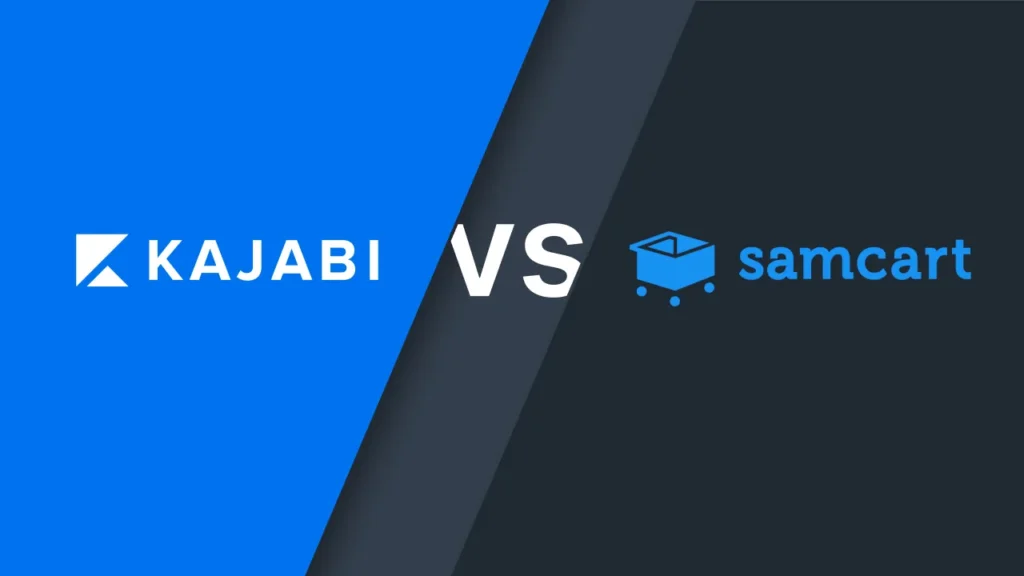
I spent time exploring Kajabi and SamCart from every angle to see where each shines and falls short. After going back and forth, I reached a clear conclusion to help you make an informed choice.
Kajabi is a versatile platform for online course businesses, excelling as a digital classroom with great student engagement and community tools. Meanwhile, SamCart stands out with its top marketing tools for boosting product sales and increasing conversion rates, making it ideal for digital product creators.
This article will guide you in choosing the best tool for your needs by comparing their features across 10 key areas:
- Ease of Use
- Marketing Automation
- Website Creation
- Online Courses
- Digital Sales and Payment Processing
- CRM Features
- Integrations
- Community
- Support
- Price
Let’s jump into the details of Kajabi vs SamCart…
What is Kajabi?

Kajabi is an all-purpose platform designed to help entrepreneurs turn their knowledge into profitable online businesses. Although the founders of Kajabi weren’t initially focused on teaching online, they were passionate about helping others do it successfully. Since its launch in 2010, Kajabi has empowered thousands of users to sell digital products like online courses, coaching sessions, and other educational content.
As an all-in-one solution, Kajabi is a central hub for everything related to running an online business. It offers the tools you need to create and market online courses, podcasts, and other knowledge-based products. Kajabi also provides robust community-building features, such as virtual and in-person events, webinars, challenges, and forums, to help keep your audience engaged.
Marketing automation is another highlight of the platform. Kajabi comes with top-tier tools to help you reach a wider audience and increase sales. Plus, its white-label website options allow entrepreneurs, influencers, and industry experts to build fully branded websites without relying on third-party tools. If you want to sell courses or build a community around your content, Kajabi gives you everything you need in one place.
If you want to learn more about Kajabi’s features and how it performs in real-world scenarios, be sure to read our in-depth Kajabi Review. This review will give you a comprehensive understanding of what Kajabi can offer your business.
What is SamCart?
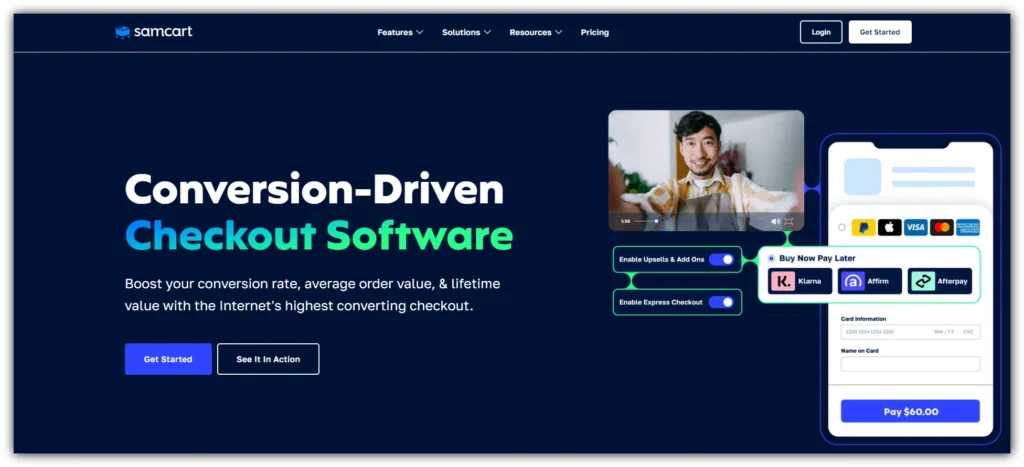
SamCart is a direct-to-consumer eCommerce platform designed to help businesses boost their conversions and maximize profits. While it includes features for creating digital products, SamCart’s primary focus is on selling and promoting those products effectively.
One of SamCart’s standout features is its easy-to-use drag-and-drop page builder. This tool allows you to create visually appealing sales pages that are optimized for conversions. It also comes with pre-designed templates, helping you sell a wide variety of products to your target audience.
In addition to this, SamCart offers several features to improve your revenue, including A/B testing, one-click upsells, order bumps, and abandoned cart recovery. Its advanced reporting tools give you insights into how your products are performing, and its integration engine lets you connect SamCart with other business software, making it easy to incorporate into your existing workflows.
Although SamCart doesn’t offer a complete website-building feature like Kajabi, it does excel in helping you optimize landing pages. With A/B testing capabilities, you can see what works best, improving your sales process and increasing conversion rates. This makes SamCart a great choice for content creators looking to sell courses, products, or services to a broader audience.
Kajabi vs. SamCart: Ease of Use
SamCart is incredibly easy to set up, as noted in our SamCart review. You can have your online store up and running in under five minutes. Its user-friendly interface lets you quickly fill in essential details like your store name, URL, logo, country, currency, and payment processor (such as PayPal or Stripe). With just a few clicks, you can start selling.
Kajabi is also relatively easy to set up, but it involves a few more steps compared to SamCart. You’ll begin by choosing a template from its wide selection, set up your products, and configure your payment processor, and then you’re good to go. While Kajabi’s setup isn’t as fast as SamCart’s, it offers plenty of tutorial videos and resources to guide you through the process.
Winner: SamCart
When it comes to simplicity and speed of setup, SamCart takes the lead, making it the more beginner-friendly option.
Kajabi vs. SamCart: Marketing Automation
Kajabi comes with built-in tools for marketing automation, while SamCart relies on third-party apps to handle these tasks.
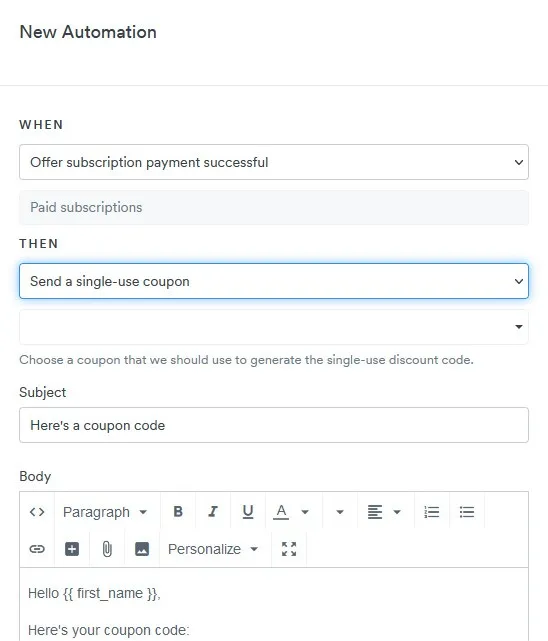
With Kajabi, you get a variety of automation tools right out of the box. You can automate email campaigns, manage events, and set up offers with ease. Kajabi also allows you to automate course delivery and trigger specific actions based on user behavior, like sending a follow-up email when a customer completes a course module.
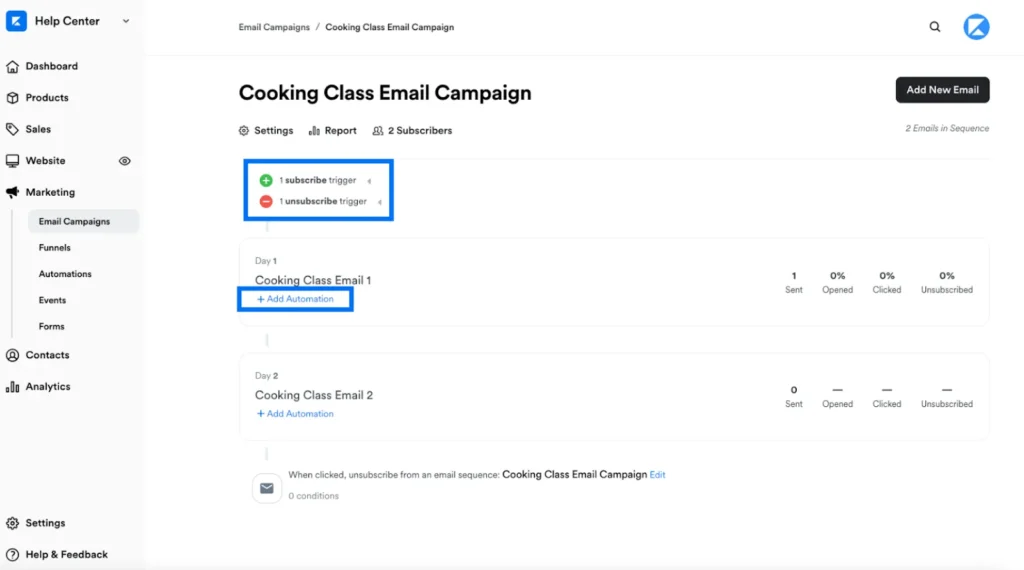
Kajabi also includes a drag-and-drop pipeline builder, which makes creating sales funnels a breeze. This feature helps you nurture leads, automate email sequences, and manage marketing campaigns directly within the platform.
In contrast, SamCart does not offer built-in automation features. Instead, it depends on integrations with third-party tools like HubSpot, Ontraport, and Klaviyo for tasks like running email campaigns and managing marketing automations.
Winner: Kajabi
If you need robust automation tools to manage sales funnels, email campaigns, and more without extra apps, Kajabi is the better choice. But if you already use third-party marketing tools and prefer to stick with those, SamCart will integrate smoothly into your existing setup.
Kajabi vs. SamCart: Website Building
When comparing Kajabi and SamCart for website creation, Kajabi stands out as it allows you to build full websites, while SamCart focuses only on creating individual sales pages.
Kajabi offers a comprehensive website builder that lets you create a complete online presence, tying together all parts of your business. With Kajabi, you can build a site to showcase your products, publish blog posts, and host various types of content. The platform is also mobile-responsive, which means your site will adjust smoothly to different screen sizes, ensuring a good experience for users on phones, tablets, or desktops.
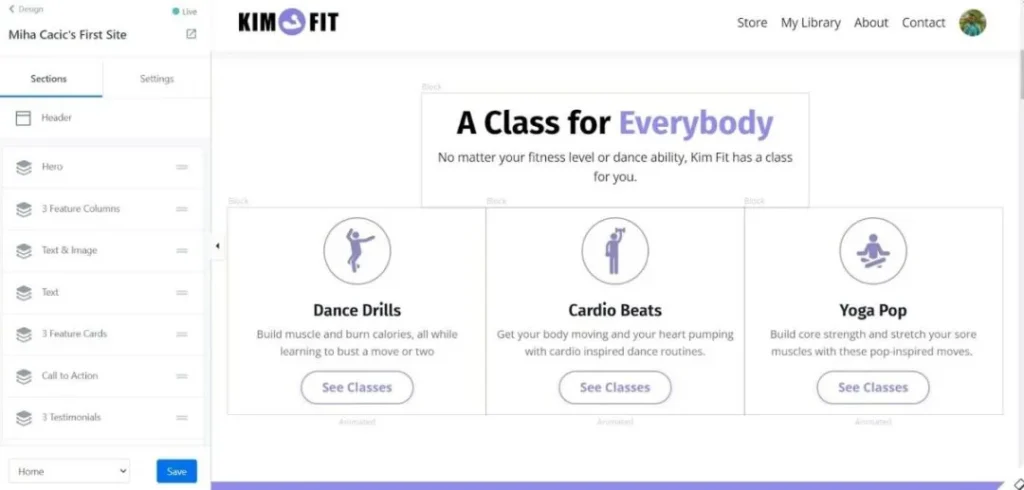
Kajabi’s website builder is designed for ease of use, and it comes with a library of pre-made templates to speed up the process. You can fully customize each page by adding images, buttons, text boxes, custom fonts, and animations. Plus, Kajabi allows you to use a custom domain, making it easier for customers to find and recognize your site.
SamCart, on the other hand, includes a drag-and-drop page builder, but it is limited to creating individual sales pages rather than a full website. These sales pages are meant to integrate with your existing website, rather than function as a standalone site.
Despite this limitation, SamCart shines with its built-in A/B testing feature, which lets you experiment with different versions of your landing pages. You can split test design elements like fonts, colors, buttons, and images to see which version leads to better conversions. SamCart will automatically rotate these variations to show different versions to your visitors and then provide detailed reports on web traffic, conversions, and payments.
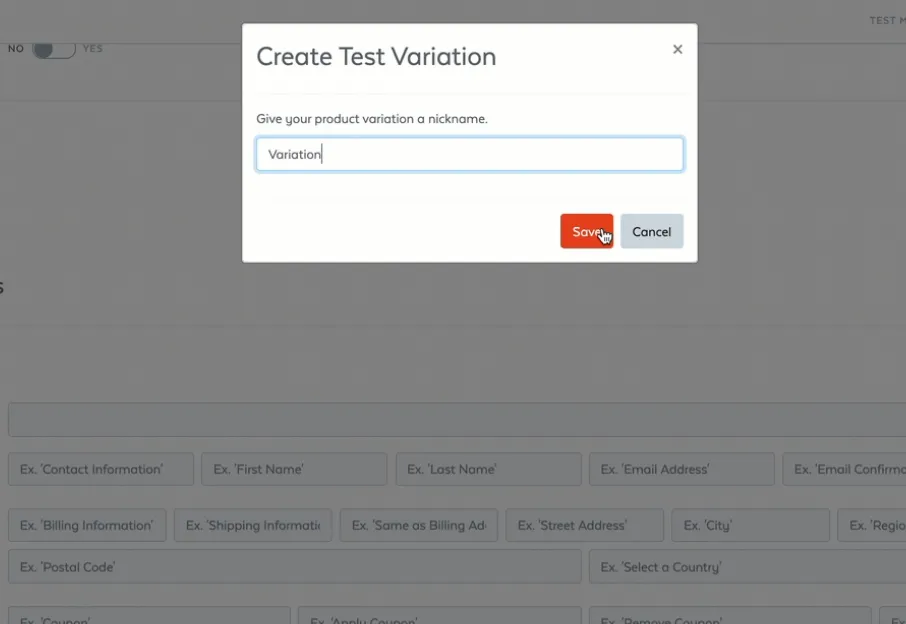
Kajabi also supports A/B testing but relies on third-party tools like Optimizely for this feature, and it offers basic built-in analytics.
Both Kajabi and SamCart come with templates for building pages, but the scope differs. SamCart offers customizable templates for landing pages, pop-ups, and web forms, with the option to save your edits as new templates for future use. Kajabi provides a variety of templates tailored to different industries, such as cooking, coding, or fitness, and allows customization with HTML and CSS if you want to go beyond the standard options.
Winner: Kajabi
If you’re looking to create a fully functional website quickly and easily, Kajabi is the better choice. For those who only need individual sales pages that can integrate with an existing site, SamCart is a solid option, especially with its advanced A/B testing features.
Kajabi vs. SamCart: Online Courses
Both Kajabi and SamCart offer simple course creation tools, but SamCart provides more customization options, making it more flexible.
SamCart is particularly intuitive for beginners. Its course builder is designed to be user-friendly, making it easy to set up courses even if you’re new to the process.
Kajabi offers a straightforward system for creating courses. It allows you to organize your content into modules and use a simple interface to fill those modules with lessons. You can add various types of content, such as videos, audio files, images, and downloadable resources. Kajabi also supports adding subtitles and closed captions to your video lessons, which is a great accessibility feature.

For video hosting, Kajabi has partnered with Wistia to offer hosting at no extra charge, although Kajabi itself doesn’t host videos. In contrast, SamCart has built-in video hosting, so you won’t need any external services for this feature.
Both platforms support scheduling courses for automatic publishing and allowing you to drip content to students over time. Kajabi also lets you lock courses or specific modules until students complete certain lessons, helping you control the learning flow.
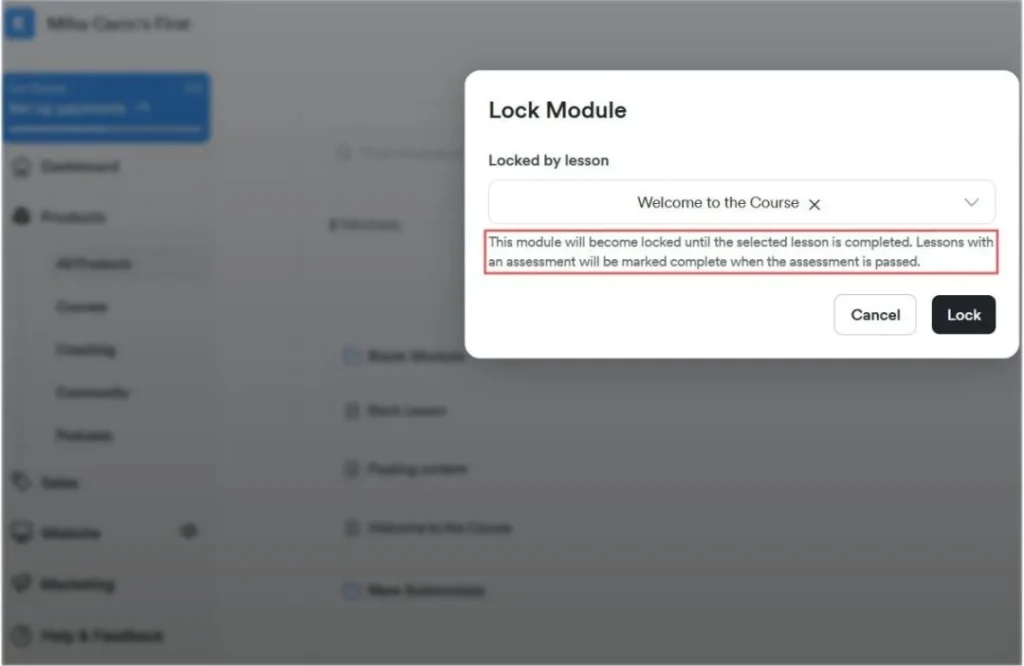
SamCart’s course builder works in a similar way but offers a more intuitive interface for tasks like adding a custom domain, including downloadable content, and creating quizzes. This makes it particularly appealing for beginners. Unlike Kajabi, where quizzes are separate lessons, SamCart allows you to embed quizzes and worksheets within the same lesson. This feature can create a smoother learning experience for students by making the flow of lessons more systematic.
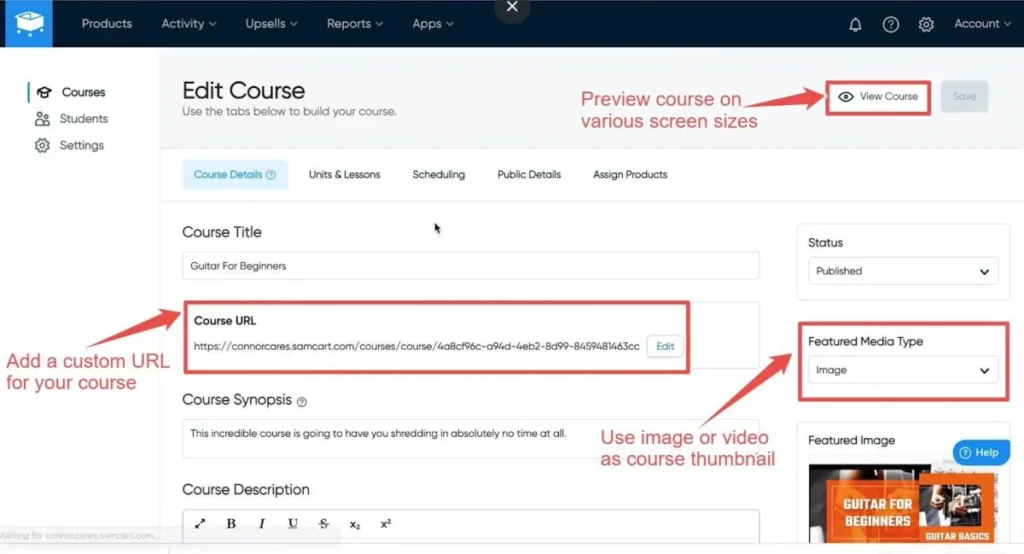
Additionally, SamCart’s text editor provides more formatting options, allowing you to highlight important sections of your course content more effectively.
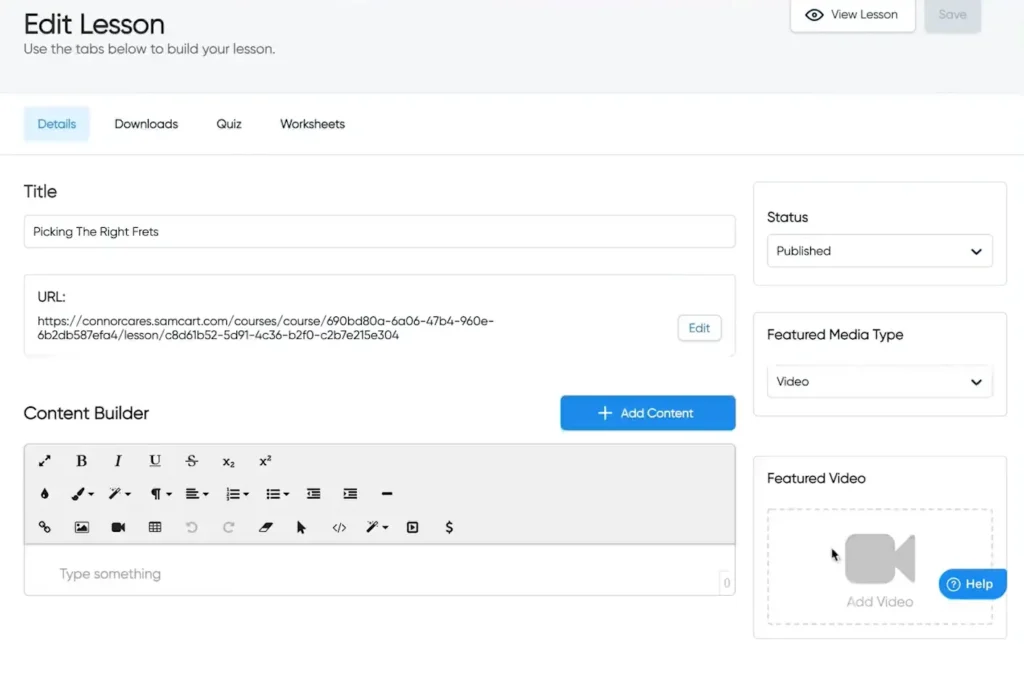
Templates for Course Pages
Both Kajabi and SamCart offer templates for course creation, but they differ in how they present them.
Kajabi provides a variety of built-in and user-made templates that can be used to create visually appealing course pages. You can choose from different styles, such as blog-like designs, gamified themes, or more creative and bright layouts. These templates can speed up the course-building process, especially if you’re looking to launch quickly.
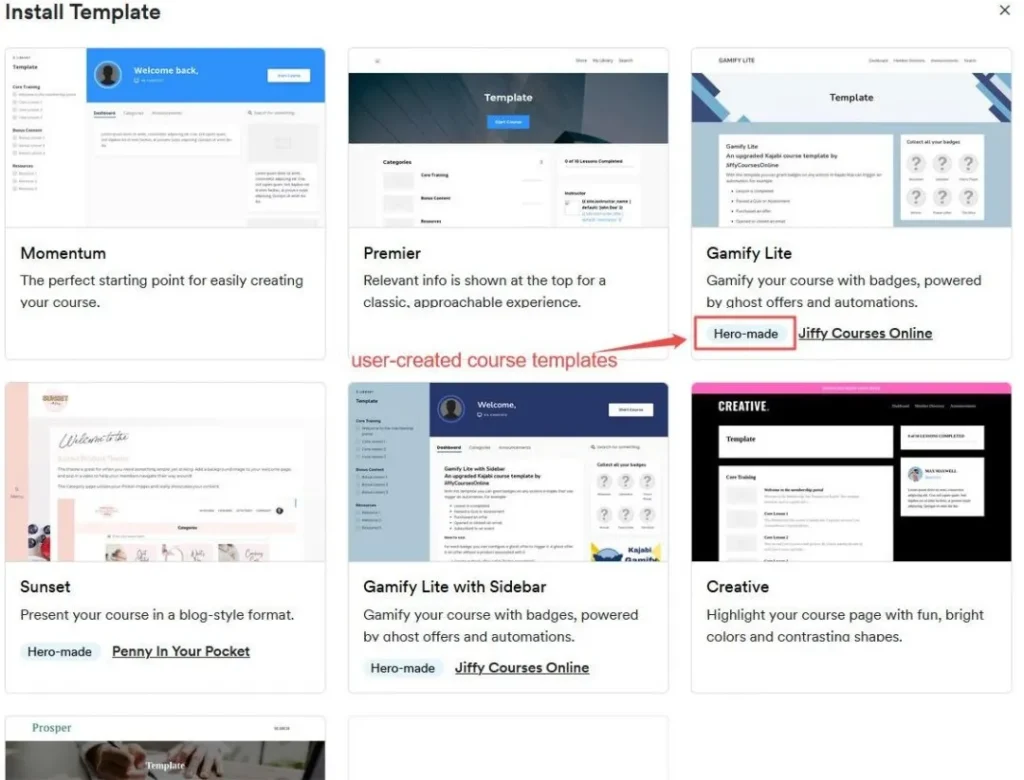
SamCart also includes pre-designed, conversion-optimized templates for sales pages. These templates are equipped with widgets that are fine-tuned to help increase conversions, meaning they’re geared toward getting more students to sign up for your courses.
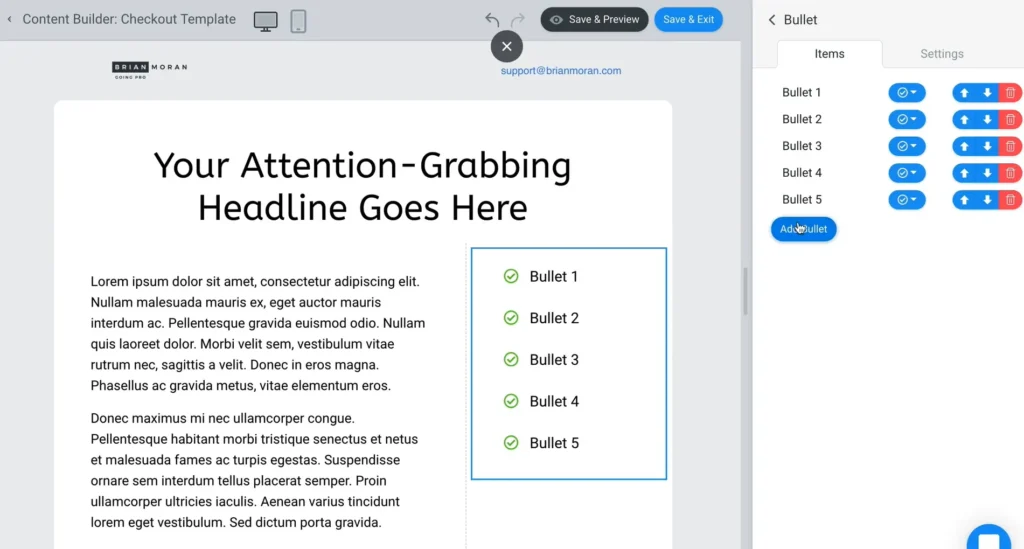
Payment Options for Online Courses
When it comes to payment options, SamCart offers more variety compared to Kajabi.
Kajabi only natively supports Stripe and PayPal for processing payments. While these are the two most popular platforms, the limited options could be a drawback for some businesses.
SamCart, on the other hand, supports not only Stripe and PayPal but also a variety of other payment processors. You can offer more checkout options to your customers, such as digital wallets like Apple Pay and Google Pay, as well as traditional credit card options like Visa and Mastercard. This wide range of payment methods can make the checkout process smoother for your audience.
Additionally, SamCart allows you to offer flexible payment options like free trials or “pay what you want” pricing models. This can help build trust with your customers, as it lets them choose how much they want to pay for your course or product.
Winner: SamCart
If you’re looking for a highly customizable, beginner-friendly course builder with more payment options, SamCart is the better choice. It offers more flexibility in payment processors, course customization, and page optimization. However, if you want to create courses quickly with built-in templates and aren’t too concerned about deep customization, Kajabi might be the better fit.
Make your courses more engaging by adding interactive elements that boost student involvement. Discover how to integrate assessments into your Kajabi courses by exploring our guide on Surveys, Quizzes & Assessments in Kajabi.
Kajabi vs. SamCart: Digital Sales and Payment Processing
When deciding between Kajabi and SamCart for selling digital products, it’s important to compare how each platform handles product setup and sales. Both Kajabi and SamCart provide easy-to-use payment processing tools, making it simple to collect payments from your customers. Additionally, both platforms allow you to offer discount coupons to help attract more buyers.
One major benefit is that neither Kajabi nor SamCart takes a percentage of your sales. This is different from some other platforms in the knowledge commerce space, where transaction fees can cut into your profits. With Kajabi and SamCart, you get to keep 100% of what you earn, giving you more freedom to grow your business without worrying about additional costs.
Both platforms support Stripe and PayPal as payment options, which are widely used and trusted. However, Kajabi has an edge when it comes to integrating payment processing with other features. For example, Kajabi offers built-in automation tools that make it easy to streamline your entire workflow, including checkout and follow-up processes.
SamCart, originally designed as a shopping cart solution, also shines in this area. Since checkout is one of SamCart’s core strengths, it includes useful features designed to make the purchase process smoother for customers. These checkout features are helpful for increasing conversions and making sales more efficient.
Winner: SamCart
SamCart takes the lead with its strong focus on optimizing the checkout process, ensuring a smooth and easy experience for both you and your customers.
Kajabi vs. SamCart: CRM Features
To effectively manage your online business, a good Customer Relationship Management (CRM) system is essential. A CRM helps you track your customers’ journey through the sales funnel, enabling you to tailor your marketing efforts and communication based on their actions and interests.
SamCart offers basic CRM features through its Student Management area, allowing course creators to enroll students and track their progress. However, for more advanced CRM functionality, SamCart relies on third-party integrations. Platforms like Keap and HubSpot can be integrated with SamCart to provide more comprehensive CRM tools, but these solutions tend to be expensive and require additional setup time.
Kajabi, on the other hand, offers a more built-in approach to CRM, specifically designed for small businesses in the knowledge commerce space. Kajabi’s CRM allows you to automate emails and offers based on customer behavior, making it easy to engage with leads and existing customers. You can set up to 100 custom fields to store valuable information about your contacts, ensuring you have the data you need to personalize your outreach and marketing.
The automation features in Kajabi’s CRM are particularly useful, allowing you to trigger emails and offers based on specific actions taken by your customers, such as completing a course module or signing up for a webinar.
Winner: Kajabi
Kajabi comes out on top for its robust, built-in CRM tools that help you manage customer relationships and automate key processes without the need for third-party integrations.
Kajabi vs. SamCart: Integrations
SamCart offers more flexibility when it comes to third-party integrations, providing over 30 native integrations with popular apps and services. Additionally, SamCart users can access up to 750 third-party apps via Zapier. These include tools like ActiveCampaign, ConvertKit, AWeber, and WordPress. Interestingly, SamCart even integrates with Kajabi, allowing for cross-platform use. For users on the Scale and VIP plans, custom API integrations are also available, giving even more flexibility.
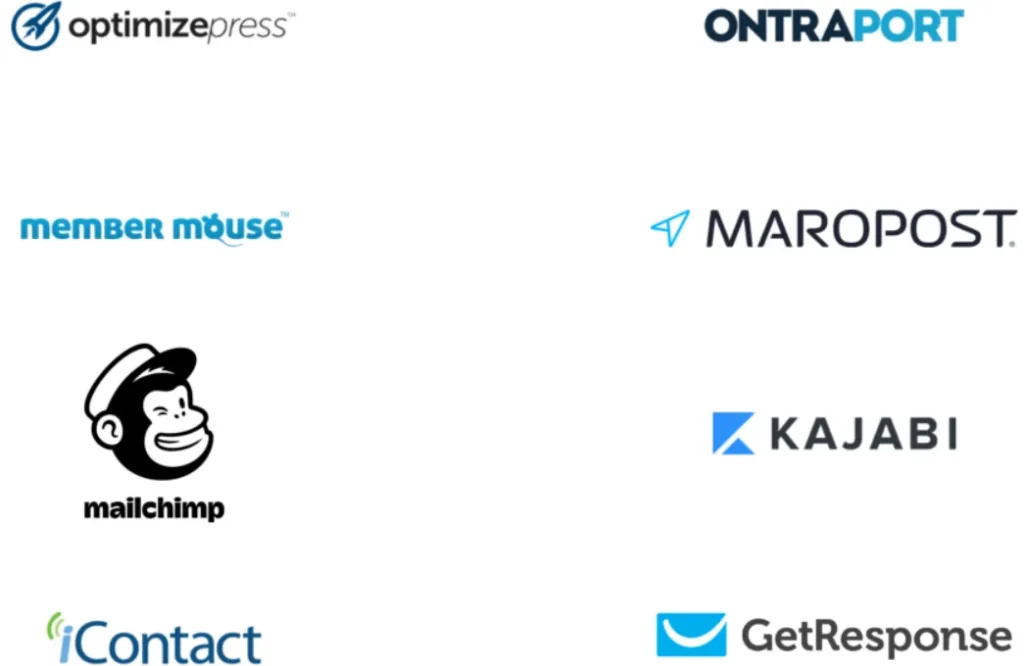
On the other hand, Kajabi focuses on being more self-sufficient, meaning it doesn’t rely as much on external tools. However, Kajabi does offer 16 integrations, including Zapier, Mailchimp, and ClickFunnels, to fill in any gaps in functionality.
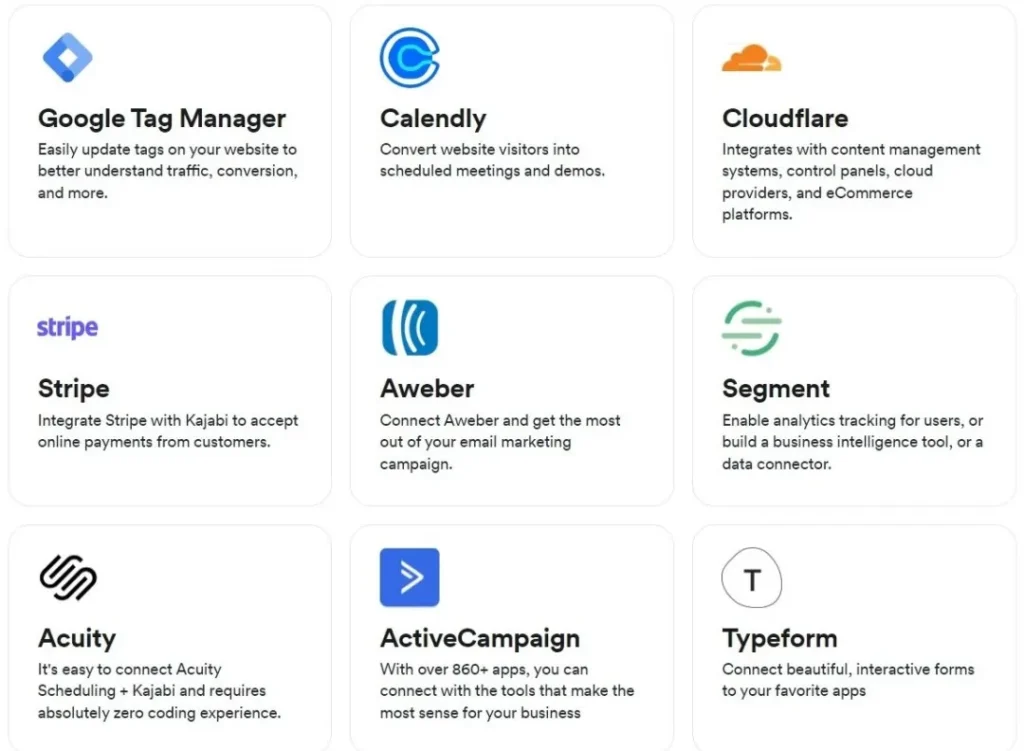
Both platforms support webhooks, allowing for custom integrations, but this requires coding knowledge.
Winner: SamCart
If you need a platform with many built-in integrations, SamCart is the better option. However, if you prefer a platform that mostly operates on its own and requires fewer external tools, Kajabi might be a better fit.
Kajabi vs. SamCart: Community Features
When it comes to building and managing online communities, Kajabi stands out with its built-in tools, while SamCart lacks native community features.
With Kajabi, you can create communities centered around your online content. Each community functions as a standalone website, hosting groups, forums, and membership sites. Members can actively engage with each other through posts, a sophisticated chat system, and participation in community events like polls and challenges.
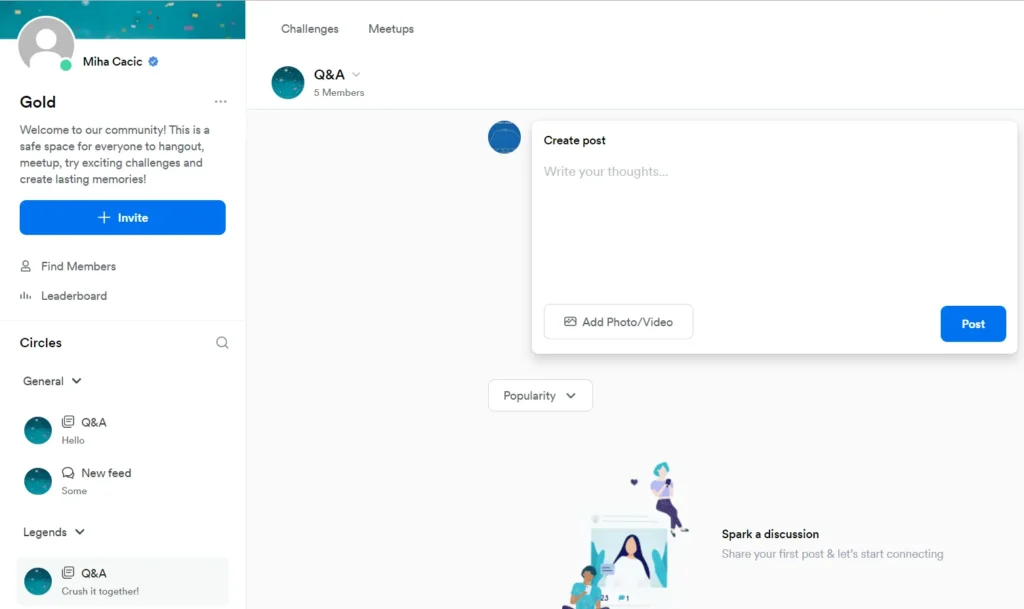
Kajabi also supports physical and virtual meetups, offering a live room for video, audio, and screen sharing during online meetings. You can even record these sessions and engage with participants through real-time chat, similar to dedicated video conferencing apps.
In contrast, SamCart does not offer native community-building features. While you can create membership lists for your courses, you’ll need to use third-party tools like Slack or Discord to foster a community.
Winner: Kajabi
Kajabi is the clear choice if you’re looking for built-in community features, complete with dedicated websites and engagement tools. If you’re using SamCart, you’ll need to rely on external tools for community-building.
Kajabi vs. SamCart: Support
Good customer support can play a major role in your success with any platform. Both Kajabi and SamCart offer a self-serve knowledge base to help users find answers to common questions on their own.
When it comes to direct support, SamCart provides email support, and users on higher-tier plans receive priority support for faster response times.
Kajabi, however, offers more comprehensive customer support. Users on its Growth and Pro plans have access to 24/7 live chat, ensuring help is available anytime you need it. Kajabi also offers an add-on called Access, which gives you one-on-one calls with a Customer Success Manager for personalized guidance.
Winner: Kajabi
Kajabi takes the lead in customer support with 24/7 live chat and the option for personalized help through the Access plan. SamCart offers decent support but is more limited, especially for users on lower-tier plans.
SamCart vs. Kajabi: Pricing
On the surface, SamCart is a lot cheaper than Kajabi. However, Kajabi does have a slightly more advanced feature set. Here’s a breakdown of SamCart Vs. Kajabi pricing to give you an idea of the key price differences between the two.
SamCart Pricing
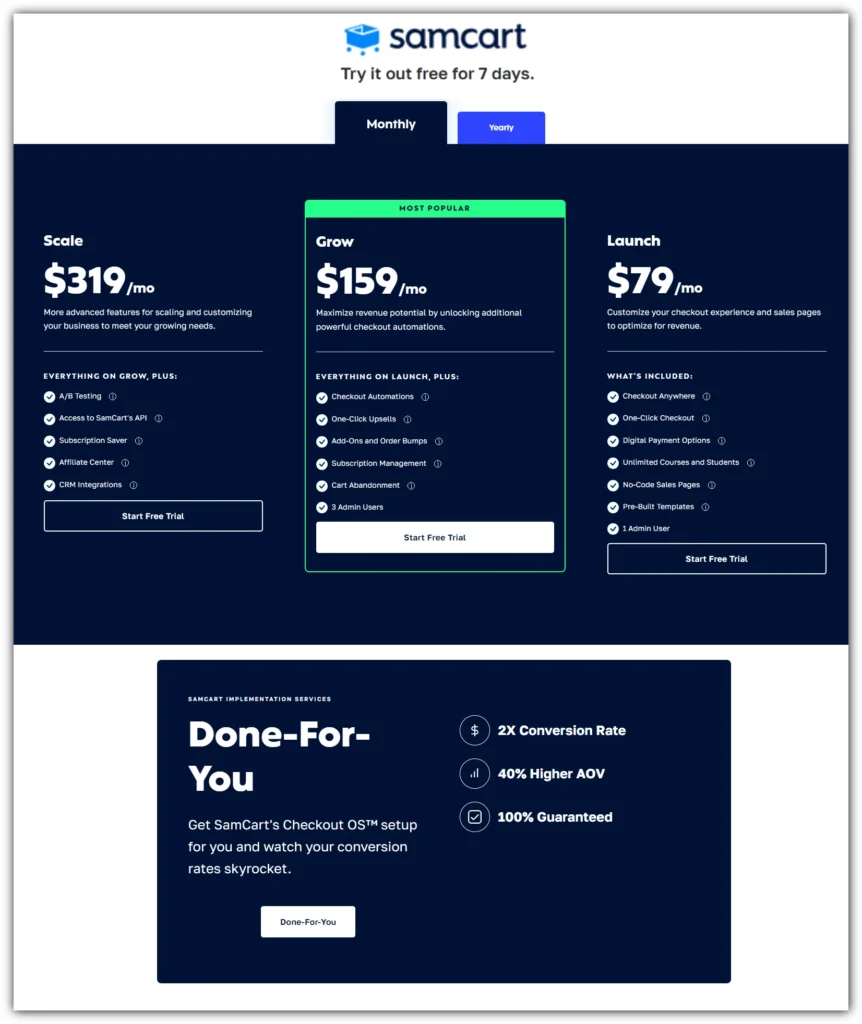
SamCart offers three pricing tiers, each catering to different business needs. All plans come with a 7-day free trial, allowing users to test the platform before committing. Here’s a detailed breakdown:
Launch Plan – $79/month
This is the entry-level plan ideal for businesses looking to get started with SamCart. It includes:
- Checkout Anywhere: Flexibility to embed SamCart’s checkout pages on any website.
- One-Click Checkout: Simplified checkout experience to boost conversions.
- Digital Payment Options: Accept payments online with various methods.
- Unlimited Courses and Students: No cap on courses or the number of students.
- No-Code Sales Pages: Pre-built templates requiring no coding experience.
- Pre-Built Templates: Customizable templates to create professional pages quickly.
- 1 Admin User: Limited to one account user.
Grow Plan (Most Popular) – $159/month
This mid-tier plan is designed to maximize revenue potential through more advanced checkout automations. It includes everything in the Launch Plan, plus:
- Checkout Automations: Streamline follow-up processes and enhance post-checkout engagement.
- One-Click Upsells: Offer upsells post-purchase to increase average order value.
- Add-Ons and Order Bumps: Add product extras at checkout to maximize sales.
- Subscription Management: Manage recurring subscriptions easily.
- Cart Abandonment: Recover lost sales through automated emails.
- 3 Admin Users: Access for up to three team members.
Scale Plan – $319/month
The Scale Plan is ideal for businesses that require advanced features for scaling. It includes everything in the Grow Plan, plus:
- A/B Testing: Run tests on different checkout pages to optimize for conversions.
- Access to SamCart’s API: For advanced integrations and customizations.
- Subscription Saver: Automated recovery for failed payments to prevent subscription churn.
- Affiliate Center: Built-in tools to manage affiliate programs and drive external traffic.
- CRM Integrations: Seamless integrations with CRM platforms for better customer management.
Done For You
SamCart also offers a Done-For-You implementation service with the following benefits:
- 2X Conversion Rate: Optimized setup for increasing conversion rates.
- 40% Higher AOV (Average Order Value): Boost your sales with strategic upsells.
- 100% Guaranteed: Guaranteed results from their tailored Checkout OS™ setup.
Kajabi Pricing
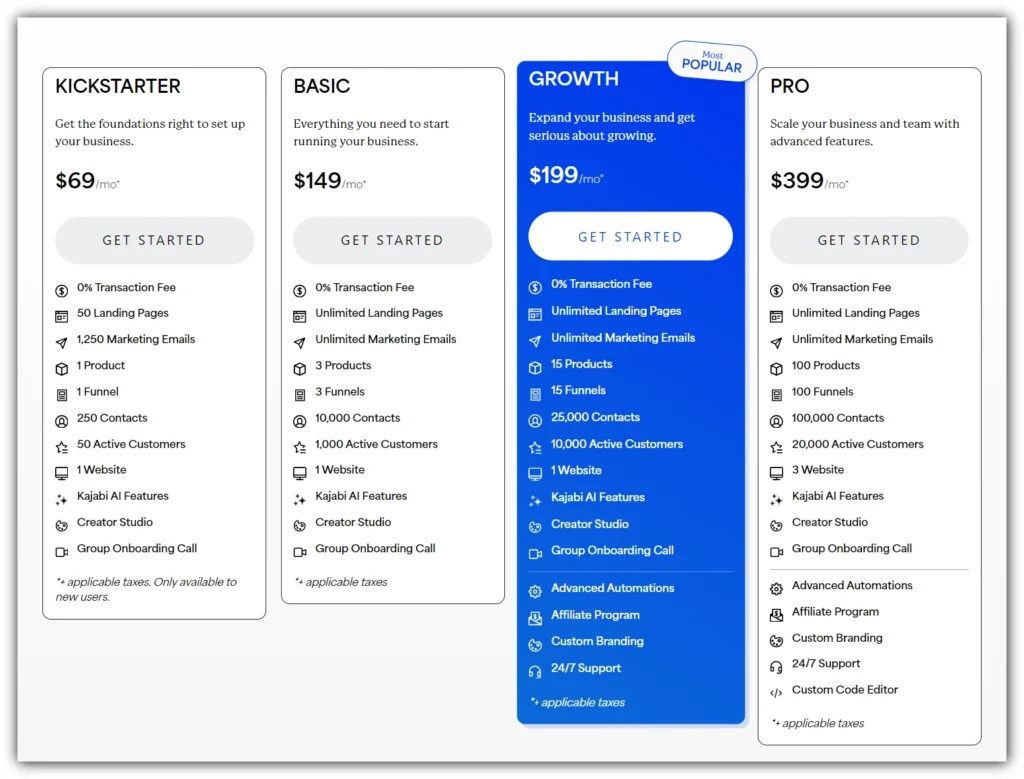
Kajabi offers four pricing tiers that cater to different business sizes and needs. Each plan includes a 14-day free trial for users to experience the platform before committing. However, if you sign up through my link, you can use Kajabi for 30-Days for free instead of 14-days standard trial. Here’s a breakdown of Kajabi’s pricing and features:
Kickstarter Plan – $69/month
This is Kajabi’s entry-level plan, ideal for businesses just starting with content creation. It includes:
- 0% Transaction Fee: No additional charges on sales.
- 50 Landing Pages: Build up to 50 customizable landing pages.
- 1,250 Marketing Emails: Send up to 1,250 emails to your audience.
- 1 Product: Offer and sell one digital product like a course or membership.
- 1 Funnel: Set up one sales funnel to automate marketing and sales processes.
- 250 Contacts: Manage up to 250 email subscribers.
- 50 Active Customers: Serve up to 50 paying customers.
- 1 Website: Launch a fully branded website.
- Kajabi AI Features: Utilize AI tools for content generation.
- Creator Studio: Create professional content with Kajabi’s built-in tools.
- Group Onboarding Call: Access to Kajabi’s onboarding support call for guidance.
Basic Plan – $149/month
Designed for small businesses looking to grow, the Basic Plan offers more flexibility. It includes:
- 0% Transaction Fee: No additional transaction costs.
- Unlimited Landing Pages: Create as many landing pages as needed.
- Unlimited Marketing Emails: Send unlimited email campaigns to your audience.
- 3 Products: Sell up to three different digital products.
- 3 Funnels: Set up three automated marketing funnels.
- 10,000 Contacts: Manage a larger email list with 10,000 contacts.
- 1,000 Active Customers: Serve up to 1,000 paying customers.
- 1 Website: Full website customization and branding.
- Kajabi AI Features, Creator Studio, and Group Onboarding Call: Included.
Growth Plan (Most Popular) – $199/month
Kajabi’s mid-tier plan for scaling businesses offers advanced features to fuel growth. It includes everything in the Basic Plan, plus:
- 15 Products: Offer and manage up to 15 different products.
- 15 Funnels: Set up 15 automated marketing funnels.
- 25,000 Contacts: Manage up to 25,000 email subscribers.
- 10,000 Active Customers: Handle up to 10,000 paying customers.
- Advanced Automations: Automate more complex marketing sequences.
- Affiliate Program: Manage and reward affiliates for promoting your products.
- Custom Branding: Tailor Kajabi to match your brand identity.
- 24/7 Support: Access to round-the-clock customer support.
Pro Plan – $399/month
The Pro Plan is built for large businesses looking for enterprise-level features. It includes everything in the Growth Plan, plus:
- 100 Products: Sell up to 100 different digital products.
- 100 Funnels: Set up and manage 100 automated marketing funnels.
- 100,000 Contacts: Manage a large email list with 100,000 contacts.
- 20,000 Active Customers: Serve up to 20,000 paying customers.
- 3 Websites: Launch and manage up to 3 fully branded websites.
- Custom Code Editor: Advanced users can further customize with code.
Kajabi vs. SamCart: Pros & Cons
Kajabi excels at engaging students and building communities, while SamCart is ideal for selling courses and boosting conversion rates.
Kajabi Pros:
- Full Website Builder: Offers a complete website-building tool with plenty of templates to choose from.
- Strong Community Features: Ideal for creating and managing online communities.
- All-in-One Platform: Combines course creation, marketing automation, and student engagement into one package.
- 24/7 Customer Support: Always available help, especially useful for troubleshooting at any time.
Kajabi Cons:
- High Cost: Expensive for individuals and small teams, which may not fit every budget.
- Limited Integrations: Fewer integration options compared to competitors, relying mainly on its own tools.
- No Built-In A/B Testing: You’ll need third-party tools for testing and optimizing pages.
SamCart Pros:
- Wide Range of Integrations: Supports many third-party apps, giving you flexibility.
- Strong Sales Features: Focuses on optimizing sales and increasing conversion rates.
- Great Course Tools: Offers easy-to-use features for building and selling online courses.
- Affordable Pricing: More budget-friendly compared to Kajabi.
- Sales Optimization Tools: Built-in tools designed to maximize sales performance.
SamCart Cons:
- No Community Features: Doesn’t include tools for building or managing communities.
- Only Individual Sales Pages: Lacks the ability to create a complete website—offers only single sales pages.
- No Built-In Marketing Automation: You’ll need external tools to automate your marketing efforts.
Final Verdict: Kajabi vs. SamCart
Both Kajabi and SamCart are powerful platforms, but they serve different purposes. Kajabi is best for those who want to focus on student engagement and creating communities. SamCart is designed for maximizing sales and building high-converting landing pages.
| Kajabi | SamCart |
| Best for: Medium to large teams offering diverse products and services. | Best for: Business owners looking to increase sales and improve conversion rates. |
So, which is the better option in the Kajabi vs. SamCart comparison? It really depends on your business goals. Both platforms are highly effective, but they cater to different needs and audiences. Here’s a quick guide to help you decide.
Use Kajabi if:
- You need to create multiple websites for different products or services.
- You sell more than just online courses and need a versatile platform.
- You want features specifically designed for community engagement.
- You like using templates to streamline your content creation.
Use SamCart if:
- Your main focus is optimizing your sales process and improving conversions.
- You want an easy-to-use tool for building beautiful landing pages quickly.
- You’re looking for a more affordable solution for creating and promoting courses.
- You need built-in A/B testing to test what works best for your business.
In simple words, both platforms are great, but your choice should be based on what fits your business model better—whether it’s engaging students and managing communities with Kajabi, or focusing on sales and conversion optimization with SamCart.
If you’re interested in monetizing your platform further, consider partnering with Kajabi. Learn how to earn commissions by promoting Kajabi through their Kajabi Affiliate Program.
Final Thoughts
In the end, both Kajabi and SamCart are excellent platforms, but each shines in different areas depending on your business needs. Kajabi is a powerful all-in-one solution perfect for building online courses, engaging students, and fostering a strong community. If your goal is to create a comprehensive learning platform or sell more than just courses, Kajabi’s robust features—like its website builder, community tools, and marketing automation—make it the ideal choice for you.
On the other hand, SamCart is designed with a clear focus on sales optimization and ease of use. Its intuitive page builder, advanced sales tools, and built-in A/B testing are perfect for entrepreneurs who want to streamline the selling process and maximize conversions. If your main goal is to create high-converting sales pages and improve your overall sales strategy, SamCart is the way to go.
Ultimately, the right choice depends on what matters most to your business—whether it’s growing a learning community or optimizing sales. Both platforms are highly effective in their own right, and by understanding your specific goals, you can confidently choose the one that will best support your success.